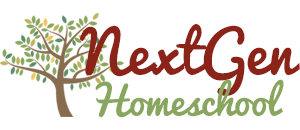 This past week — per my three girls’ eager request — we started school a few weeks earlier than I had planned. I’m sure the fact that their neighborhood friends had already started back to the local public school had something to do with it. But whatever the reason, I was glad to see they were so excited to start — even if I wasn’t.
This past week — per my three girls’ eager request — we started school a few weeks earlier than I had planned. I’m sure the fact that their neighborhood friends had already started back to the local public school had something to do with it. But whatever the reason, I was glad to see they were so excited to start — even if I wasn’t.
Truth be told, I’m still in the process of purchasing curriculum, gathering books and lining up homeschool co-ops and extracurricular activities for us to participate in. However, I thought this could be a good opportunity to do some core skills review and test out the new systems I have set up to keep us running more smoothly this year — and hopefully, keep the school area from becoming a dysfunctional chaotic mess as well.
In the past, I have organized and reorganized several times throughout the school year. So far nothing has stuck with us: Not a single curriculum package, filing system or “cubby” shelving strategy, daily planner or homeschool tracking system. We live and we learn, especially in a homeschool environment. Although I’ve pinned many colorful, quaint schoolroom photos and snappy organizational tools and tips to my Pinterest dreamboard, I had yet to come up with something both beautiful and functional for our family.
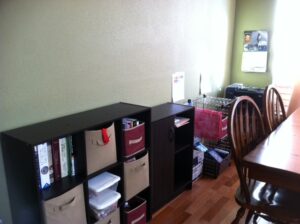
This summer, my goal was to take what was actually working for us and improve upon it in a more organized way. Not a radical revamp, but a refinement — and beautification — of our homeschooling area and systems. Here’s a glimpse of what I’ve been up to the past two months to “gear up” for back-to-school time…
Shopping for deals
One of the most important factors I believe most homeschoolers face when planning for the new school year is a budget: We’ve all got one, and for some (myself included), it can be pretty tight. Over the past two years, I’ve learned to dismiss past memories of the long and “necessary” school supplies lists provided by classroom teachers and create a list of the tools we do actually use throughout the school year. This step in and of itself saves you money, as well as the fact you’re not limited to certain brands when you are the teacher making that judgement call.
Personally, I’m not brand loyal when it comes to consumable school items like pens, pencils, crayons, paper, notebooks, folders, glue, etc. I know my girls, and I don’t expect things like a subject binder to last more than one school year: Whether the favorite color changes, the scribbles on the front cover are no longer cool, or they’re no longer into Hello Kitty, they will probably need and/or want some new things. So I stay alert to the weekly deals at each local store and gradually compile the new year’s supplies when things are super cheap — and by super cheap, I mean 50 cents, a penny and even free at times!
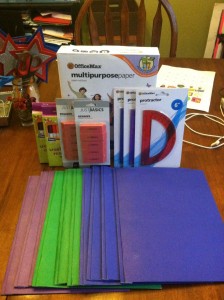
The consumables I mentioned above always go on sale somewhere at some point for as little as a penny or free. This year, I have purchased all of the above for 10 cents or less. I’ve even filled up a box of items we can use for our Operation Christmas Child boxes this fall. OfficeMax has consistently offered free items every week since July when you spend $5 or more on “non-Max-value” items. To make the most of this, I have purchased a $5 item that also qualifies for a full in-store rebate, so that eventually I’ll get that $5 back too.
For anything more expensive, like a new backpack, lunchbox, or advanced art supplies, I wait for clearance and/or steep discount coupons. With this strategy, I’ve been able to assemble a great art toolbox that includes acrylic paints, pastels, charcoals, canvases, glue guns, fabric glue, etc., as well as update the backpacks and lunchboxes every couple of years.
I believe you can stock up your homeschool area with all the supplies you’ll need for a productive year very inexpensively. Curriculum, on the other hand, isn’t as easy to come by for free or at a discount unless you’re willing to spend some time researching your options — and be patient. For more advice on curriculum savings, see our recent “Ask a NextGen Homeschooler” post on this topic.
Refining an almost-functional system
While I was filling the top shelf of the pantry with boxes of this year’s school supplies, I did my best to keep the girls from impulsively putting new items into the existing school area. I knew that we would continue to use the “formal” dining area for school (fully visible from our front door), and that new furniture to reorganize (or just hide) the overflowing cubby bins and teetering stacks of books and folders was not in the budget. So refining — and hopefully beautifying — our existing space was my best option. Until that was accomplished, I wanted nothing new to be buried in the existing clutter.
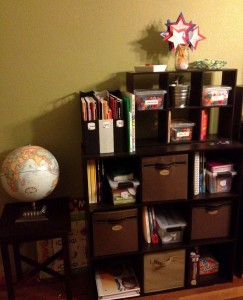 I figured out one thing that was working for the girls and had the potential of keeping our school area pretty clean and pristine: The cubby bins. However, the fabric bins I purchased last year got stretched out by the weight of heavy workbooks, and the handles became shabby and weak from constant use. That was an easy fix: I purchased new, more sturdy, fabric bins with leather handles. They fit our existing shelves perfectly and look great.
I figured out one thing that was working for the girls and had the potential of keeping our school area pretty clean and pristine: The cubby bins. However, the fabric bins I purchased last year got stretched out by the weight of heavy workbooks, and the handles became shabby and weak from constant use. That was an easy fix: I purchased new, more sturdy, fabric bins with leather handles. They fit our existing shelves perfectly and look great.
This was my one “splurge” in the prep process (about $9 per bin). I debated repurposing baskets I already had in use elsewhere or purchasing less expensive options, but the bottom line was that they had to be the right size for the shelves (so they didn’t stick out) and sturdy enough for daily use. Since this shelf can literally be seen from our front door, I also wanted them to match and fit into the color scheme of the rest of the decor for that room — something that didn’t scream “kid zone” as loudly as before.
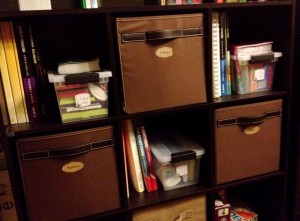 Within each cubby are conveniently camouflaged workbooks, 3×5 card file boxes, library books, journals, spiral notebooks, and anything else that would not easily stack on a visible shelf. Next to each girl’s cubby is an exposed shelf that holds her curriculum books (which usually stack quite neatly), her bible, and her new personal school supplies box (more on that later). The girls love it, and it’s easier on the eye than last year’s stacks and stacks of books and folders falling from the shelves.
Within each cubby are conveniently camouflaged workbooks, 3×5 card file boxes, library books, journals, spiral notebooks, and anything else that would not easily stack on a visible shelf. Next to each girl’s cubby is an exposed shelf that holds her curriculum books (which usually stack quite neatly), her bible, and her new personal school supplies box (more on that later). The girls love it, and it’s easier on the eye than last year’s stacks and stacks of books and folders falling from the shelves.
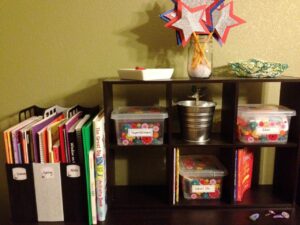 Next step was keeping tools like pens, crayons, highlighters, and such in an easily accessible place that could also be easily cleaned up at the end of the day. For this, I purchased two types of clear bins: One per child with tools that are specific to them (and that they can take with them to other areas of the house or outside to work with), and another that is “all purpose” and divided by tool type (crayons, colored pencils, highlighters, markers, etc.) This — hopefully — solves two previous problems: They now have both a portable solution where their personal tools are self-contained, as well as school “area” tools that are easy to clean up and don’t belong to anyone (preventing constant “that’s mine!” arguments).
Next step was keeping tools like pens, crayons, highlighters, and such in an easily accessible place that could also be easily cleaned up at the end of the day. For this, I purchased two types of clear bins: One per child with tools that are specific to them (and that they can take with them to other areas of the house or outside to work with), and another that is “all purpose” and divided by tool type (crayons, colored pencils, highlighters, markers, etc.) This — hopefully — solves two previous problems: They now have both a portable solution where their personal tools are self-contained, as well as school “area” tools that are easy to clean up and don’t belong to anyone (preventing constant “that’s mine!” arguments).
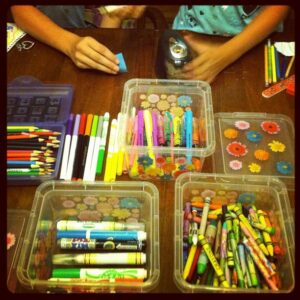 To complete this task, I enlisted the girls to help me sort through boxes and Ziploc bags full of crayons, markers, etc. We tossed out every dried-up marker, chewed-up crayon, and nub of a pencil, and aggregated all the “worth using” implements into their specific boxes. When we were done, the girls were thrilled. “I am so glad we did this Mom,” one shared. “Now when I want to work on something, I won’t waste any time with junk that doesn’t work!”
To complete this task, I enlisted the girls to help me sort through boxes and Ziploc bags full of crayons, markers, etc. We tossed out every dried-up marker, chewed-up crayon, and nub of a pencil, and aggregated all the “worth using” implements into their specific boxes. When we were done, the girls were thrilled. “I am so glad we did this Mom,” one shared. “Now when I want to work on something, I won’t waste any time with junk that doesn’t work!”
Mission accomplished.
So far, this new system of splitting up the school supplies is working as planned. When someone is in the mood to color or work on a school project at the dining/school table, they can pull down whatever supplies are necessary — share with whomever has decided to join them — and put the supplies back quickly when finished. On the other hand, someone who wishes to work alone outside on the patio table or in their bedrooms can take their personal toolbox and do so easily, as long as they return the toolbox to the school area shelf. We’ll see how this holds up, but so far it seems to be efficient and keeping our school area clean.
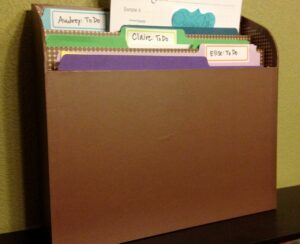 The last area that needed work was the student/teacher “in-out” box. This year, I took a leveled file folder stand from my personal desk and gave each girl a “to do” folder: In the evening, I put print-outs and any independent work for the next day in their folders, and when they’ve completed them and I am done checking them, I’ll put them back in the folder so they can be added to their individual binders later.
The last area that needed work was the student/teacher “in-out” box. This year, I took a leveled file folder stand from my personal desk and gave each girl a “to do” folder: In the evening, I put print-outs and any independent work for the next day in their folders, and when they’ve completed them and I am done checking them, I’ll put them back in the folder so they can be added to their individual binders later.
My goal with this system is to have independent work ready so the girls can start whenever they are ready in the morning and go back to it during times of the day when I am not working with them directly. Plus I can find their finished work easily when it’s time for me to review it.
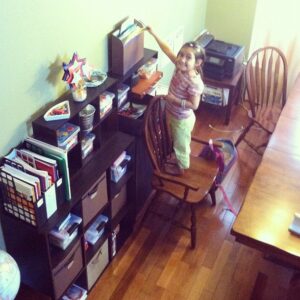 This has been one of the easiest fixes to make a big impact: This Saturday, my 5-year-old (Kindergartener) Elise noticed that she already had sheets in her “to do” folder for Monday, and asked if she could just work on them right now. Why not? She ended up completing Monday’s work in about 30 minutes and starting on a new creative art project, which is also almost done. Now instead of catching up next week because we had friends in town visiting for two days, she is actually ahead of the lesson plan. I love this new system!
This has been one of the easiest fixes to make a big impact: This Saturday, my 5-year-old (Kindergartener) Elise noticed that she already had sheets in her “to do” folder for Monday, and asked if she could just work on them right now. Why not? She ended up completing Monday’s work in about 30 minutes and starting on a new creative art project, which is also almost done. Now instead of catching up next week because we had friends in town visiting for two days, she is actually ahead of the lesson plan. I love this new system!
One other previously troublesome issue was the easy accessibility of extra “supplies” that the girls or I might need during the school day — everything from refill staples and tape to scratch paper and ink for the printer. To meet this need, I brought down a nice set of portable drawers from my home office to use for everything extra that I wanted tucked away neatly.
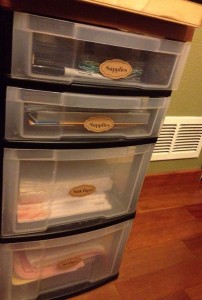 This has also turned out to make a huge difference right off the bat. The girls know exactly where the extras can be found and aren’t wandering up to my office for tape or paper clips, and there are no longer stacks of extra everything sitting on the dining room table waiting to be put away at some later time. Everyone was able to get their school work done without having to wander around for supplies, and the area was returned to a relatively clean state at the end of each work period. Victory, as far as I’m concerned!
This has also turned out to make a huge difference right off the bat. The girls know exactly where the extras can be found and aren’t wandering up to my office for tape or paper clips, and there are no longer stacks of extra everything sitting on the dining room table waiting to be put away at some later time. Everyone was able to get their school work done without having to wander around for supplies, and the area was returned to a relatively clean state at the end of each work period. Victory, as far as I’m concerned!
Although I wasn’t expecting to get “started” with school in mid-August, I am thankful that this week of review and test-run of our refined school area has been both successful and fun — re-energizing my daughters and giving me some peace of mind that this year we might be able to maintain an active — and attractive — school area. I am really looking forward to implementing our new curriculum and other exciting plans for this new year in September (more on that later). Until then, I hope you’re off to an inspired start as well — and if not, that you’ve received some helpful info from my sisters and I to get yourself and your family ready for a great start very soon!
“And whatever you do, do it heartily, as to the Lord and not to men, knowing that from the Lord you will receive the reward of the inheritance; for you serve the Lord Jesus Christ.” — Col. 3:23
What are your strategies for getting ready for a new homeschool year? How do you save money on curriculum and tools? Do you reorganize your school area? Do you re-evaluate your curriculum? Tell us about your homeschool prep in the comments below.
